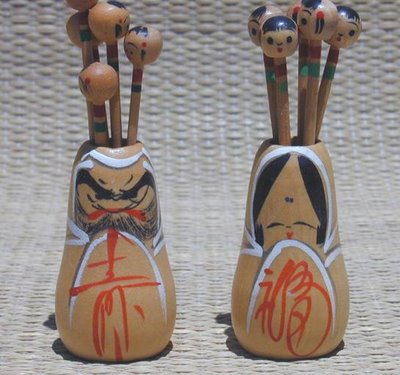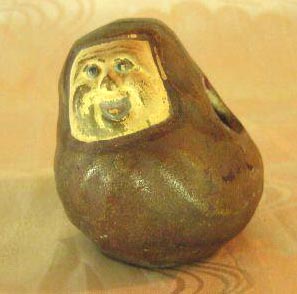:::::::::::::::::::::::::::::::::::::::::::::::::::::::::::::::::::::::::::::::::::::::::::::::::::::
Toothpicks-holder
Tsumayooji (tsumajoji) 爪楊枝 つまようじ
A pair from wood, sold as a souvenier

::::::::::::::::::::::::::::::::::::::::::::::::::::::::::::::::::::::::::::::::::::::::::::::::::::
Made from pottery

Photo from my friend Emi san.
Toothpick holder
from Sanda Celadon
::::::::::::::::::::::::::::::::::::::::::::::::::::::::::::::::::::::::::::::::::::::::::::::::::::
Quote from Koeisha & Co.
The birth of the toothpick
The "Probe", a magazine for dentist published in England (Jan.1990) reports as follows.
[Before man devised the axe he may have invented the toothpick! Anthropologists now believe that early men,as they sat around the fire after a hard day's hunting, picked their teeth---after chewing the meat they had killed---with sticks cut to a sharp point.
Evidence of Stone Age toothpicks is indirect but compelling, say anthropologists.
The evidence? Marks on fossil teeth.Analysis of these marks has led to the consensus that they were made by heavy toothpick use by our early ancestors.
The grooves were especially common in the teeth of Neanderthals who lived in Europe and Asia, about 100,000 years ago. Similar markings have been found in the fossilized Teeth of both American Indians and Australian Aborigines.
Commented Professor Christy Turner, who is an expert on anthropology at the Arizona State University: "As far as can be empirically documented, the oldest human habit is picking one's teeth."]
As people lived wildly and did not know how to cook and eat in soft at this age, ;the teeth was very important. If he lost his teeth, he might face to death. It's really [teeth is life itself.]
Eating that is most basic action depends on teeth. At this age that people did not know to cure their teeth.Only care is the method to maintain their teeth.
As soon as people begun the action of eating, they tried clean their teeth instinctively.
We have to admire the wisdom of early men. This branch of wood is the beginning of toothpick and tufted toothbrush.
When we imagine Neanderthals pick their teeth with the branch of wood, we feel very intimate to us. It's also reported that some kinds of chimpanzee brush their teeth with the branch of wood. They know the importance of teeth instinctively.
Along with Buddhism
Toothpick was introduced into Japan in 584(Nara period). It was brought in with Buddhism via China and Korea.
Buddha (500BC) had originally taught his disciples to clean their teeth with tufted toothbrush. In India they used twigs from Neem tree and others. They called them [danta-kashuta] in Sanskrit. [Danta] is the origin of dental and [kashuta] means twig.
As they did not grow in China the poplar was used instead. The Chinese and Japanese word for poplar is YO and for branch JI, hence the name YOJI or TSUMAYOJI for toothpick in Japanese.
Even now in India [Danta] means 32, the number of teeth.
Tuft toothbrush is still used at present.
Tuft toothbrush is used in many countries as one of sundry items. India,Pakistan,Bangradish,SaudiArabia,Nigeria, Guinea,Senegal,Mali,Sudan,Tanzania, Tunisia, Court geboir,Burukinafasso ,Ethiopia,ets. Neem,Babool and Basil are used in India., Peeru in Pakistan, Salvadra in Saudi Arabia, Walnuts in many African countries.
In these countries traditional tuft toothbrush is sold at roadside or Souk (market) and used in common. Generally one side of stick is bitten, but bark of tree such as walnuts are used also cutting in 2~3 centimeter.
In Tunisia tuft toothbrush is sold at drugstore of Souk where natural medicine are adjusted for personal disease. There branches are sold for men and barks (5 centimeter in width, 15centimeter in length)for women. Men bite it anywhere, but women use it in gentle way.
SPREAD TO THE NOBLE in Japan
The toothpick that had been introduced with Buddhism has penetrated into usual life of Buddhism monk serving to Buddha after shaping up by rinsing of mouth and brushing of teeth. It did not take so much time to convey this clean custom of Buddhism monk to the noble. Among them officers of the Court and Shinto priests begun to imitate their clean custom.
The Prime Minister Morosuke Fujiwara (907~960) transported to his descendant that cleaning the mouth with tuft toothbrush and washing the face must be done as daily manner in the book of [kujyoudenn yuikai].

SPREAD TO THE PUBLIC
Toothpick begun to be used by Buddhism monk in Nara period (710~784), and spread to the noble in Heian period (794~1192).
When was it to spread to the public? To know this fact we find nice documents of songs which was song in plantation of rice. They are labor songs praying fruitful harvest.
In these song the toothpick was included in many time.
・ Sharpening the white beard of Dragon to the toothpick
・ The owner of field to plant today has a gold toothpick in his mouth
・ Loquat tree in symbolic India is suitable for toothpick
・ Let's have toothpick dying by the essence of Azalea
・ Dropping my favorite toothpick made of willow and wisteria
・ Very good toothpick is made of willow
・ Owner of the field, we plant today looks happy because he sit on thousands of container of rice and use gold toothpick
Song of plantation for rice is song of the public. Trough these we see toothpick had spread widely to the public. These songs were completed in middle age from the end of Muromachi age (1338~1573) to Azuchi Momoyama age (1574~1602).
As the Buddhist Dougen in Kamakura age (1192 - 1333) described in his book [Shoubougennzou]that in Japan people use toothpick commonly.
APPAERANCE OF TOOTHBRUSH
As the toothbrush was imported from foreign countries especially USA at the beginning of Meiji period (around 1870-1895), tuft toothbrush have disappeared.
Why tuft toothbrush was taken the place by toothbrush?
It's because that as tuft toothbrush is lineal, it's very difficult to clean both side of teeth and left parts of tuft brush remain in mouth. It's impossible to use so often. Moreover Japanese have tendency of introduction of new item.
Then much to our regret the tuft toothbrushes that have had history of 1200 years and continued so much maintain their teeth clean disappeared rapidly.
The independent toothpick that is one more side of tuft toothbrush has remained.
Let's watch the process of introduction of toothbrush.
Situation of foreign articles and trade of importation are described with pictures in the book of [Bankoku Shouhou Ourai] written by H.Matunaga in 1874.
The toothbrush is described as [polishing toothpick] and toothbrush holder is expressed as [toothpick holder]. [Toothpick] is the name of toothbrush when toothbrush was imported.
Read the original with many illustrations here
source : www.japanskedanmark.dk
Koeisha & Co., Ltd.
:::::::::::::::::::::::::::::::::::::::::::::::::::::::::::::::::::::::::::::::::::::::::::::::::::::

Yoji楊枝, also the word for the pick of wagashi sweets at the Tea Ceremony.
Toothpicks were sold at the many shops around the famous temple of the Asakusa Kannon in Edo.
In 1807, there were more than 220 shops in the district.
The back of the temple was most famous.
奥山の楊枝(ようじ)屋

and the girl who sold them there, Yanagiya no O-Fuji 柳屋お藤, was among the idols of the town.
. Asakusa Kannon 浅草観音 .


yoojiten, yooji ten 楊枝店 toothpick shop
in Asakusa
.................................................................................
- Carved from the wood of
kuromoji 黒文字 クロモジ spice bush,
Lindera umbellata
A kind of camphor tree with delicate smell.
In the town of 久留里 Kururi in Chiba, there was a castle called
ujo 雨城 "rain castle".
The Samurai of this domain went out of work during the Meiji period and many begun carving toothpicks with decorations and in various forms for special situations, called
雨城楊枝 "toothpicks from the Rain Castle".

They planted the
kuromoji tree in their gardens to have the material ready.
The toothpicks were used to eat Wagashi 和菓子 sweets or fruit, for the tea ceremony and many other purposes.
To our day, only one family is making these toothpicks.

CLICK for more samples !
- Their homepage
- reference source : geocities.jp/ujyouyoujimorihonke -

on facebook :
- reference source : facebook.com/ujyouyouji -
:::::::::::::::::::::::::::::::::::::::::::::::::::::::::::::::::::::::::::::::::::::::::::::::::::::::::::::::::::::::::::
observance kigo for the New Year
Yooji joosui kaji 楊枝浄水加持 Ceremony of cleaning toothpicks
Nowadays also performed on the 18th of June.
百味供養会 "Ritual for the 100 tasts"
source with photos : youjijyousuikaji.html
SAIJIKI – NEW YEAR OBSERVANCES
fusayōji 房楊枝 Fusayoji, toothpick with a tuft
Often used by the courtesans. Tsukioka Yoshitoshi
:::::::::::::::::::::::::::::::::::::::::::::::::::::::::::::::::::::::::::::::::::::::::::::::::::::
yoojibashira 楊枝柱 "toothpick pillar"
The corner pillar of the host's mat is partly hidden.
jojibashira

. Tea Ceremony - Introduction 茶の湯 .
:::::::::::::::::::::::::::::::::::::::::::::::::::::::::::::::::::::::::::::::::::::::::::::::::::::
[ . BACK to WORLDKIGO . TOP . ]
[ . BACK to DARUMA MUSEUM TOP . ]
#yoojitoothpick #toochpick #tsumayoji #fusayoji
:::::::::::::::::::::::::::::::::::::::::::::::::::::::::::::::::::::::::::::::::::::::::::::::::::::










7 comments:
yooji kezuri 楊枝削り making toothpicks
a side job in Edo
yoojibashira 楊枝柱 "toothpick pillar"
The corner pillar of the tea ceremony host's mat is partly hidden.
- Kappa Goods 河童グッズ - Introduction -
Kappapedia - toothpick holder
.
Legends about toothpicks
Edo, Sendagaya
Once おまんの方 Oman no Kata had a strong toothache.
A priest at temple 千寿院 / 仙寿院 Senju-In in Shibuya, Tokyo made a 楊枝 toothpick from enoki 榎 a nettle tree. She touched her aching tooth with this little stick and in no time her pain was gone.
This is one of the 千駄ヶ谷 seven wonders of Sendagaya, Tokyo.
.
https://gokurakuparadies.blogspot.com/2015/12/ryugeji-dragon-flower-temples.html
.
楊枝
21 legends to explore
Nichibun Yokai Database
.
Tokyo 東京都
吉祥寺村 Kichijojimura Legend
yooji 楊枝 toothpick
In the compound of the 井の頭弁天堂 Bentendo Hall at Inokashira there was yanagi 柳 an old willow tree.
The toothpicks for the third Shogun Iemitsu have been made from its branches.
.
https://edoflourishing.blogspot.com/2018/10/kichijojimura-village-musashino.html
.
The tooth brush is called
"tsuma hake 妻はけ" tsumahake 。
The gay quarter women used toothbrush frequently for good reasons.
Here is an example of a woman using a tooth brush, from Utagawa Kuniyoshi's series, Ishibe: Woman with Toothbrush, from the series Fifty-three Pairings for the Tōkaidō Road, Ishibe (石部) (Tōkaidō gojūsan tsui 東海道五十三対), 1845–46
:
https://ukiyo-e.org/image/mfa/sc167120
.
Post a Comment